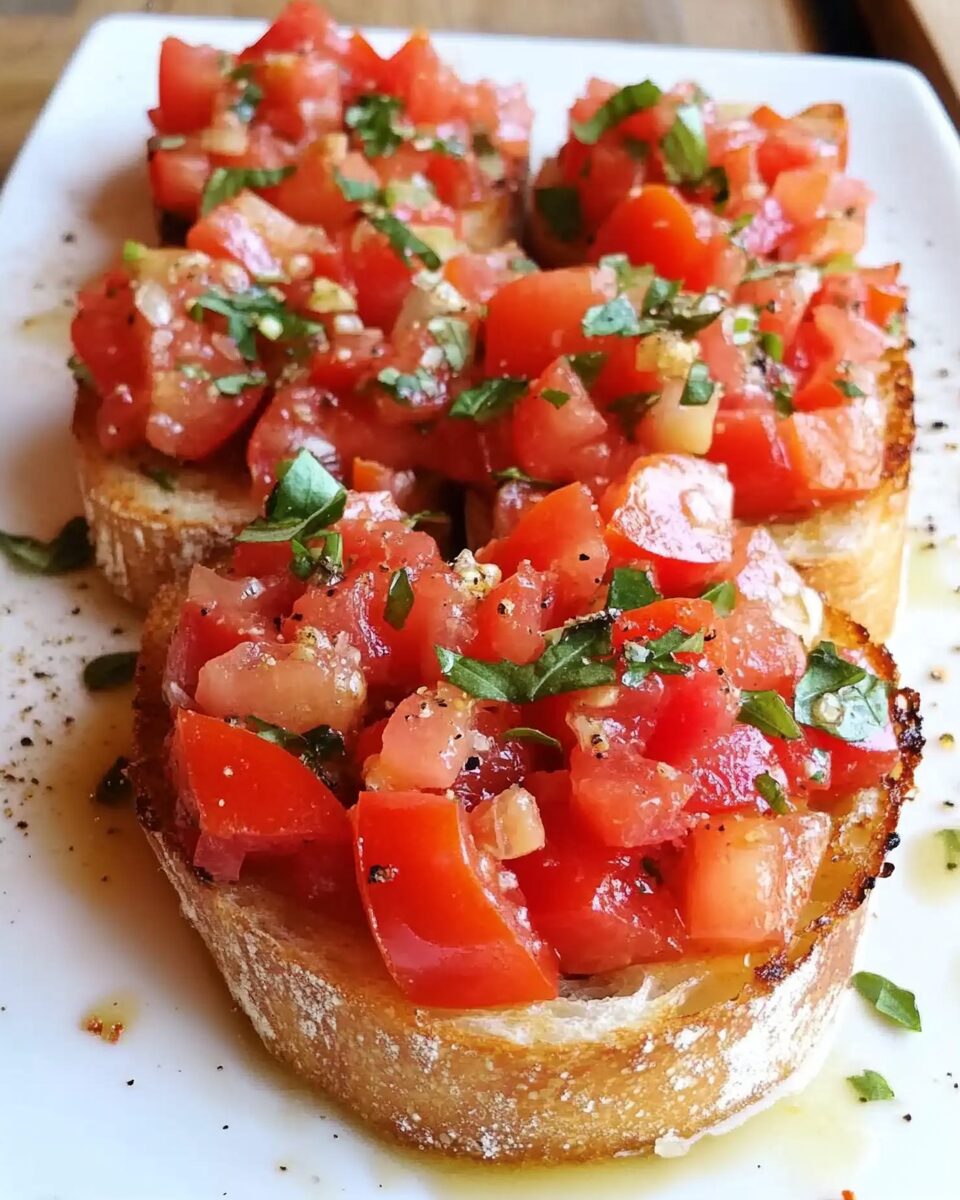Bruschetta is a timeless Italian classic that combines simple, fresh ingredients to create a delightful burst of flavor. Juicy ripe tomatoes, fragrant basil, and a touch of garlic are layered onto crisp baguette slices, delivering the perfect bite every time.
This versatile dish is not only quick and easy to prepare but also a crowd-pleaser for any occasion. Whether served as an appetizer for a dinner party, a light snack, or a side dish, bruschetta embodies the essence of Mediterranean cuisine with its fresh and wholesome ingredients.
Full Recipe:
Ingredients:
- 1 baguette, sliced into 1/2-inch slices
- 4 large ripe tomatoes, diced
- 2 cloves garlic, minced
- 1/4 cup fresh basil leaves, chopped
- 3 tablespoons olive oil
- 1 tablespoon balsamic vinegar
- Salt and pepper to taste
- Optional: Parmesan cheese, grated
Directions:
- Preheat the oven to 400°F (200°C). Arrange the baguette slices on a baking sheet.
- Toast the bread in the oven for 5-7 minutes or until golden brown. Remove and set aside.
- In a medium bowl, combine the diced tomatoes, garlic, basil, olive oil, balsamic vinegar, salt, and pepper. Mix well.
- Spoon the tomato mixture onto each toasted baguette slice. Optionally, sprinkle with grated Parmesan cheese for added flavor.
- Serve immediately and enjoy the burst of fresh, savory flavors!
Prep Time: 10 minutes | Cooking Time: 7 minutes | Total Time: 17 minutes
Kcal: 125 kcal | Servings: 6 servings
The Origins of Bruschetta
Bruschetta, pronounced “broo-SKEH-tah,” has its roots in central Italy, specifically in the Tuscany and Lazio regions. The word “bruschetta” comes from the Italian verb bruscare, which means “to roast over coals.” Traditionally, bruschetta was made by grilling slices of rustic bread and rubbing them with garlic while still warm, followed by a drizzle of olive oil. It was a way for farmers to utilize stale bread while creating a flavorful snack or appetizer.
Key Ingredients and Their Role
- Tomatoes: Use the freshest, ripest tomatoes for the best flavor. Roma or plum tomatoes work exceptionally well because they are less watery and have a robust taste.
- Basil: Fresh basil leaves provide a fragrant, slightly sweet herbal note that complements the acidity of the tomatoes.
- Garlic: Adds a sharp, spicy flavor that elevates the dish. Rubbing garlic directly on the toasted bread also ensures an even distribution of flavor.
- Olive Oil: High-quality extra virgin olive oil is essential. It ties all the ingredients together with its rich, fruity flavor.
- Baguette: A crusty baguette or ciabatta bread forms the perfect base for the toppings, offering a satisfying crunch with every bite.
Tips for the Perfect Bruschetta
- Use Stale Bread: Traditionally, bruschetta was made with day-old bread to prevent waste. Slightly stale bread works better for toasting as it holds its structure.
- Toast for Texture: To achieve the perfect crunch, lightly brush the bread with olive oil before toasting. Avoid over-toasting to maintain a slight chewiness inside.
- Serve Immediately: Assemble and serve bruschetta just before eating to prevent the bread from becoming soggy.
- Customize Your Toppings: Add a sprinkle of Parmesan cheese, a dash of balsamic glaze, or even a drizzle of honey for a creative twist.
Nutritional Information
Bruschetta is a healthy appetizer, especially when made with fresh ingredients. Each serving is relatively low in calories, around 125 kcal, and offers a good balance of carbohydrates, healthy fats, and a small amount of protein. It’s also a great source of vitamins C and A, thanks to the fresh tomatoes and basil.
Pairing Suggestions
Bruschetta pairs wonderfully with:
- Drinks: A crisp white wine like Pinot Grigio or Sauvignon Blanc enhances the fresh flavors of the dish. For a non-alcoholic option, try sparkling water with a slice of lemon.
- Main Courses: Serve as a starter for pasta dishes like Spaghetti Carbonara or Fettuccine Alfredo.
- Soups and Salads: Combine with a light soup such as Minestrone or a refreshing Caprese salad for a complete Italian-inspired meal.
Fun Fact
Bruschetta was traditionally prepared during olive harvests in Italy. Farmers would taste-test their freshly pressed olive oil by drizzling it over toasted bread and enjoying it as a quick snack while working in the fields.
The History and Origin of Bruschetta
Bruschetta originated in Italy as a simple, rustic dish to use up stale bread. Farmers would grill slices of bread over open flames, rub them with garlic, and drizzle olive oil on top. This practice dates back to ancient Rome when olive oil was first produced, and the dish was used to showcase the quality of the fresh oil. Over time, bruschetta evolved, and toppings like tomatoes, basil, and other fresh ingredients were added to create the version we know and love today.
Why This Recipe Works
- Fresh Ingredients: The recipe relies on the natural flavors of ripe tomatoes, fresh basil, and garlic. Minimal seasoning allows the ingredients to shine.
- Easy and Quick: With only a few steps and basic pantry staples, this dish can be prepared in under 20 minutes.
- Versatile: Bruschetta can be served as an appetizer, snack, or light meal. It’s also easily adaptable for different tastes and dietary needs.
Pro Tips for Making the Best Bruschetta
- Choose Quality Tomatoes: Roma or heirloom tomatoes work best because they’re less watery and pack more flavor. Removing seeds can help prevent soggy bread.
- Don’t Skip Garlic: Rub the garlic directly on the toasted bread while it’s still warm for a subtle, even flavor.
- Use Good Olive Oil: A high-quality extra virgin olive oil adds richness and depth to the dish.
- Toast Bread Properly: Lightly brush the bread slices with olive oil before toasting for an even, golden crust.
- Assemble Just Before Serving: To keep the bread crisp, add the tomato topping just before serving.
Bruschetta Variations
While the classic tomato and basil bruschetta is a staple, there are endless variations to try:
- Caprese Bruschetta: Add slices of fresh mozzarella and drizzle with balsamic glaze.
- Avocado Bruschetta: Mash avocado and mix with lime juice, then top with tomatoes and chili flakes.
- Mushroom Bruschetta: Sauté mushrooms with garlic and thyme, and use as a topping.
- Strawberry Bruschetta: Swap tomatoes for diced strawberries and add a drizzle of honey and balsamic vinegar.
- Pesto Bruschetta: Spread a layer of basil pesto on the bread before adding the tomato mixture.
Nutritional Benefits
Bruschetta is a healthy, low-calorie dish. Each serving provides:
- Antioxidants: From fresh tomatoes and basil, which are rich in vitamins A and C.
- Healthy Fats: From olive oil, which is heart-healthy and anti-inflammatory.
- Fiber: From the bread and tomatoes. This makes it a guilt-free snack or appetizer.
When to Serve Bruschetta
Bruschetta is perfect for:
- Parties and Gatherings: A simple appetizer that’s always a crowd-pleaser.
- Holiday Meals: A light starter for festive occasions.
- Weeknight Dinners: Quick to prepare when time is limited.
- Picnics and BBQs: Easy to transport and serve outdoors.
Common Mistakes to Avoid
- Overloading the Bread: Too much topping can make the bread soggy and hard to eat.
- Using Unripe Tomatoes: Ripe, juicy tomatoes are essential for the best flavor.
- Serving Cold: Serve bruschetta slightly warm or at room temperature for the best experience.
- Skipping Seasoning: A pinch of salt enhances the flavors significantly.
Conclusion
Bruschetta is a simple yet flavorful dish that showcases the best of Italian cuisine. Its fresh ingredients and versatility make it perfect as an appetizer, snack, or light meal. With minimal effort and high-quality ingredients, you can create a dish that’s both elegant and delicious. Whether served traditionally or with creative twists, bruschetta is always a crowd-pleaser.

